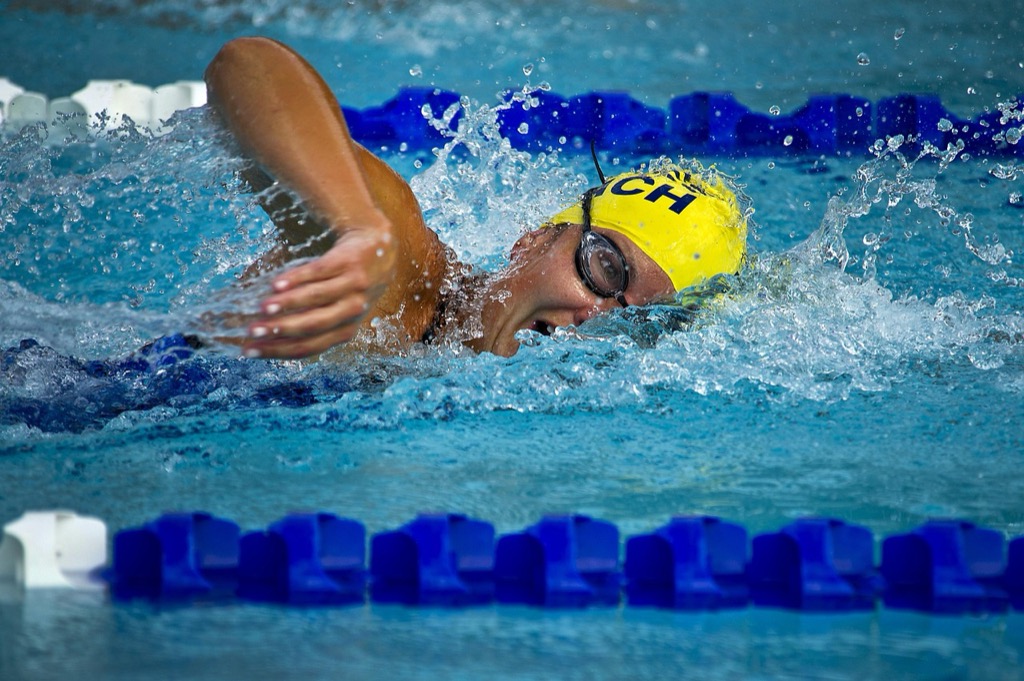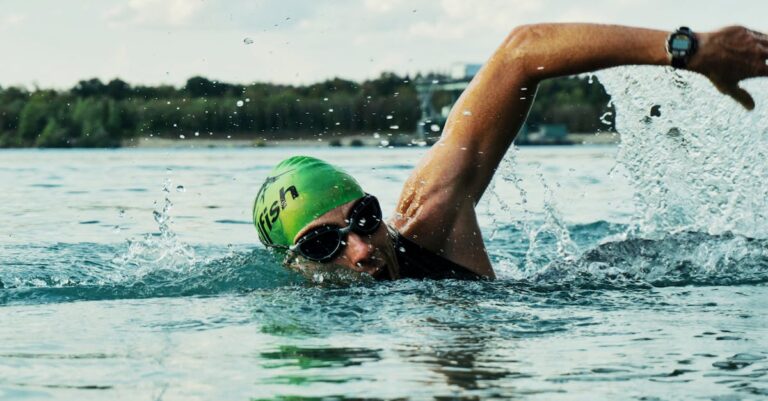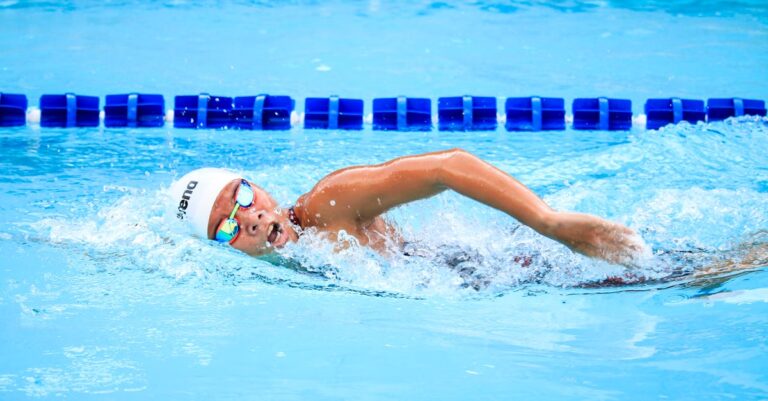7 Best Strategies for Improving Swim Technique Pro Athletes Swear By
Master swimming efficiency with 7 proven strategies covering body position, breathing, stroke mechanics, kick technique, timing, flexibility, and targeted drills.
Why it matters: Poor swimming technique wastes energy and limits your speed no matter how hard you train. Most swimmers plateau because they focus on distance rather than form.
The bottom line: Mastering proper technique transforms your swimming from exhausting struggle to effortless gliding through water. Small adjustments to your stroke mechanics can dramatically improve your performance and reduce fatigue.
What’s ahead: These seven evidence-based strategies will help you swim faster with less effort by targeting the most common technical flaws that hold swimmers back.
Disclosure: As an Amazon Associate, this site earns from qualifying purchases. Thank you!
Master Your Body Position and Alignment
Your body position in the water determines whether you’ll glide efficiently or fight against resistance with every stroke. Think of your body as a torpedo – the straighter and more streamlined you are, the faster you’ll move through the water.
Maintain a Horizontal Body Line
Position your body parallel to the water’s surface from head to toe. Your hips should float near the surface, not sink toward the pool bottom. Press your chest down slightly to lift your hips – this counterintuitive move creates the straight line you need.
Keep Your Head in Neutral Position
Look straight down at the pool bottom with your head in line with your spine. Don’t lift your head to breathe or look forward, as this instantly drops your hips and creates drag. Your waterline should hit right at your hairline.
Engage Your Core for Stability
Tighten your abdominal muscles throughout each stroke to maintain your body’s straight alignment. Your core acts like a bridge connecting your upper and lower body movements. Strong core engagement prevents your body from rotating excessively and keeps you stable through the water.
Perfect Your Breathing Technique
Breathing efficiently transforms your swimming from a survival struggle into rhythmic flow. Poor breathing habits create tension and disrupt your stroke timing more than any other technical flaw.
Develop Bilateral Breathing Patterns
Bilateral breathing every third stroke creates balanced muscle development and prevents your stroke from becoming lopsided. You’ll develop stronger technique on both sides while maintaining better body position throughout your swim. Practice alternating breathing sides to build this essential skill gradually.
Time Your Breath With Your Stroke
Your breathing should sync perfectly with your arm recovery phase when your body naturally rotates. Exhale steadily underwater through your nose and mouth then take a quick breath as your arm exits the water. This timing prevents you from lifting your head and disrupting your streamlined position.
Practice Breathing Drills Regularly
Dedicate 10-15 minutes of each swim session to specific breathing exercises like bobbing and side-kicking drills. These drills build lung capacity and teach proper exhale timing while maintaining relaxed shoulders. Consistent practice makes efficient breathing automatic during longer swimming sessions.
Focus on Proper Stroke Mechanics
Your stroke mechanics form the foundation of efficient swimming, transforming raw effort into forward propulsion. Mastering these technical elements builds upon your body position and breathing rhythm to create seamless movement through the water.
Optimize Your Catch and Pull Phase
Catch the water early by reaching forward and pressing your hand down at a 45-degree angle rather than pulling straight back. Your fingertips should enter first, followed by your wrist and forearm in one fluid motion. Pull with your entire forearm as a paddle, not just your hand, to maximize water displacement and generate more power per stroke.
Maintain High Elbow Position
Keep your elbow higher than your hand throughout the underwater pull phase to create maximum surface area against the water. This position engages your larger back muscles rather than relying solely on smaller arm muscles. Practice the catch-up drill to reinforce this elbow-up position, as dropping your elbow reduces stroke efficiency by up to 40%.
Coordinate Your Arm and Body Rotation
Rotate your torso 30-45 degrees with each stroke to engage your core muscles and extend your reach without overextending your shoulders. Your opposite arm should begin its recovery as your pulling arm passes under your chest. Think of your body as a log rolling in the water – this rotation generates power from your strongest muscle groups while reducing strain on your shoulders.
Develop Efficient Kick Technique
Your kick technique directly impacts your swimming efficiency and overall performance. While many swimmers focus primarily on arm strokes, an effective kick provides crucial propulsion and body stability.
Master the Flutter Kick Fundamentals
Keep your legs straight but relaxed with toes pointed slightly inward. Generate power from your hips rather than your knees to create a smooth whip-like motion. Maintain a narrow kick width of about 12-18 inches to minimize drag while maximizing propulsion through consistent rhythm.
Balance Power and Energy Conservation
Focus on a sustainable kick rate of 2-6 beats per arm stroke cycle. Save your most powerful kicks for sprint intervals and race finishes. During longer distances maintain a gentle flutter that provides stability without exhausting your leg muscles prematurely.
Practice Kick Drills for Strength
Incorporate kickboard sets of 25-50 yards at varying intensities into your training routine. Practice vertical kicking in deep water for 30-60 seconds to build core strength and leg endurance. Add fins occasionally to develop proper kick mechanics and increase ankle flexibility.
Improve your kicking technique with the Sunlite Sports Kickboard. Its ergonomic design and non-slip grip offer comfortable support for effective swim training, whether you're a beginner or seasoned swimmer.
Improve Your Stroke Timing and Rhythm
Your stroke timing creates the foundation for efficient swimming. Poor rhythm wastes energy and disrupts the natural flow your body needs to move smoothly through water.
Find Your Optimal Stroke Rate
Finding your optimal stroke rate means discovering the sweet spot between speed and endurance. Count your strokes per minute during comfortable swimming – most efficient swimmers maintain 60-80 strokes per minute for distance events. Test different rates during practice to identify what feels sustainable while maintaining good form and forward momentum.
Synchronize Arms and Legs
Synchronizing your arms and legs creates a unified propulsion system that maximizes efficiency. Your kick should complement your arm stroke rather than compete with it – coordinate your leg beats with your arm entry and catch phases. Practice the catch-up drill to feel how your arms and legs work together in perfect timing.
Use a Tempo Trainer for Consistency
Improve your golf swing tempo and build muscle strength with this training aid. The weighted head and flexible shaft promote proper weight transfer and body alignment for a more powerful, controlled swing.
Using a tempo trainer eliminates guesswork and builds muscle memory for consistent stroke timing. Set the beeper to match your target stroke rate and focus on hitting each beep with your hand entry. Start with longer intervals and gradually decrease the beep frequency as your rhythm becomes more natural and automatic.
Build Flexibility and Mobility
Your swimming technique improves dramatically when your body moves freely through its full range of motion. Limited flexibility creates compensation patterns that waste energy and reduce stroke efficiency.
Incorporate Shoulder Stretches
Tight shoulders restrict your reach and rotation, forcing shorter strokes that limit your distance per stroke. Perform doorway stretches and cross-body arm pulls daily to maintain shoulder mobility. Target your anterior deltoids and chest muscles specifically, as these areas tighten from repetitive forward motion during swimming.
Improve Ankle Flexibility
Stiff ankles reduce your kick’s propulsive power and create drag through inefficient foot positioning. Practice pointing and flexing your feet while seated, holding each position for 30 seconds. Focus on calf stretches and toe touches to increase your ankle’s range of motion for better water catch.
Add Dry Land Mobility Work
Dynamic warm-ups before pool sessions prepare your joints for swimming’s complex movement patterns. Include arm circles, leg swings, and torso rotations to activate your kinetic chain. Schedule 10-15 minutes of mobility work three times weekly, emphasizing hip flexors and thoracic spine rotation for improved stroke mechanics.
Practice Specific Swim Drills Regularly
Targeted swim drills transform technique faster than simply swimming laps. You’ll build muscle memory for proper mechanics while isolating specific movement patterns that need improvement.
Use Catch-Up Drill for Stroke Length
Catch-up drill extends your stroke reach and improves timing coordination. You’ll swim freestyle while keeping one arm extended forward until the other arm catches up. This drill forces you to fully extend each stroke and prevents rushing your timing. Practice this drill for 25-50 meter intervals to develop longer, more efficient strokes.
Practice Single Arm Drills for Technique
Single arm drills isolate each side of your stroke for focused improvement. You’ll swim using only one arm while the other remains at your side or extended forward. This technique helps you identify strength imbalances and timing issues between your dominant and non-dominant sides. Alternate arms every 25 meters to develop symmetrical stroke mechanics.
Incorporate Fingertip Drag Drills
Fingertip drag drills improve your arm recovery and elbow position. You’ll swim freestyle while dragging your fingertips along the water’s surface during the recovery phase. This drill ensures you’re maintaining a high elbow position and prevents overreaching. Focus on keeping your elbow higher than your hand throughout the entire recovery motion.
Conclusion
Your swimming technique improvement journey requires patience and consistent practice. These seven strategies work together to create a more efficient and enjoyable swimming experience that’ll help you move through the water with less effort and greater speed.
Remember that small adjustments can lead to significant improvements over time. Focus on mastering one technique element before moving to the next and don’t expect overnight transformations.
The key to long-term success lies in regular practice and maintaining awareness of your body position stroke mechanics and breathing patterns. With dedication to these fundamentals you’ll develop the smooth efficient technique that makes swimming feel effortless rather than exhausting.
Frequently Asked Questions
What is the most important aspect of swimming technique?
Proper body position and alignment form the foundation of efficient swimming. Your body should maintain a horizontal line like a torpedo, with hips floating near the surface and head in a neutral position looking straight down. Engaging your core provides stability and prevents excessive rotation, allowing you to glide smoothly through the water with minimal drag.
How can I improve my breathing technique while swimming?
Develop bilateral breathing patterns by breathing on both sides to promote balanced muscle development. Time your breaths with the arm recovery phase to maintain streamlined position. Practice breathing drills regularly to build lung capacity and keep your shoulders relaxed. This transforms swimming from a struggle into a rhythmic flow.
What are the key elements of proper stroke mechanics?
Enter the water fingertips first with your hand at a 45-degree angle to maximize water displacement. Maintain a high elbow position during the underwater pull to engage larger back muscles. Coordinate arm movement with body rotation, rolling like a log in the water to enhance reach and power while reducing shoulder strain.
How should I develop an efficient kick technique?
Keep your legs straight yet relaxed, generating power from your hips rather than your knees. Maintain a narrow kick width to minimize drag and find a sustainable kick rate for distance swimming. Practice kick drills using a kickboard and vertical kicking exercises to build strength and improve mechanics.
What is the ideal stroke rate for swimming?
The optimal stroke rate typically ranges between 60-80 strokes per minute for distance events. Test different rates during practice to find what feels sustainable while maintaining good form. Use a tempo trainer to build muscle memory for consistent timing and gradually adjust the frequency as your rhythm improves.
Why is flexibility important for swimming performance?
Limited flexibility leads to compensation patterns that waste energy and reduce stroke efficiency. Focus on shoulder stretches like doorway stretches to improve reach, and work on ankle flexibility through pointing and flexing exercises. Include dynamic warm-ups targeting hip flexors and thoracic spine rotation for better stroke mechanics.
Which swim drills are most effective for technique improvement?
Practice the catch-up drill to extend stroke reach and improve timing coordination. Use single arm drills to isolate and enhance each side of your stroke. Incorporate fingertip drag drills to refine arm recovery and maintain high elbow position. These targeted drills accelerate technique improvement through focused practice.







